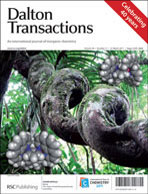The neutral and one-electron oxidized group 10 metal, Ni(II), Pd(II) and Pt(II), six-membered chelate Salpn (Salpn = N,N′-bis(3,5-di-tert-butylsalicylidene)-1,3-propanediamine) complexes have been investigated and compared to the five-membered chelate Salen (N,N′-bis(3,5-di-tert-butylsalicylidene)-1,2-ethanediamine) and Salcn (N,N′-bis(3,5-di-tert-butylsalicylidene)-1,2-cyclohexane-(1R,2R)-diamine) complexes. Reaction of the Salpn complexes with 1 equivalent of AgSbF6 affords the oxidized complexes which exist as ligand radical species in solution and in the solid state. The solid state structures of the oxidized complexes have been determined by X-ray crystal structure analysis. While the Ni and Pt analogues exhibit an essentially symmetric coordination sphere contraction upon oxidation, the oxidized Pd derivative exhibits an asymmetric metal binding environment demonstrating at least partial ligand radical localization. In comparison to the oxidized Salen and Salcn complexes, the propyl backbone of the Salpn complexes leads to a larger deviation from a planar geometry in the solid state. The electronic structure of the oxidized Salpn complexes was further probed by UV-vis-NIR measurements, electrochemistry, EPR spectroscopy, and theoretical calculations. The intense NIR band for the one-electron oxidized Salpn complexes shifts to lower energy in comparison to the 5-membered chelate analogues, which is attributed to lower metal dxz character in the β-LUMO for the Salpn series. The reactivity of the one-electron oxidized Salpn complexes with exogenous ligands was also studied. In the presence of pyridine, the oxidized Ni analogue exhibits a shift in the locus of oxidation to a Ni(III) species. The oxidized PtSalpn complex rapidly decomposes in the presence of pyridine, even at low temperature. Interestingly, electronic and EPR spectroscopy suggests that the addition of pyridine to the oxidized Pd analogue results in initial dissociation of the phenoxyl radical ligand, likely due to the increased flexibility of the propyl backbone.


 Please wait while we load your content...
Please wait while we load your content...